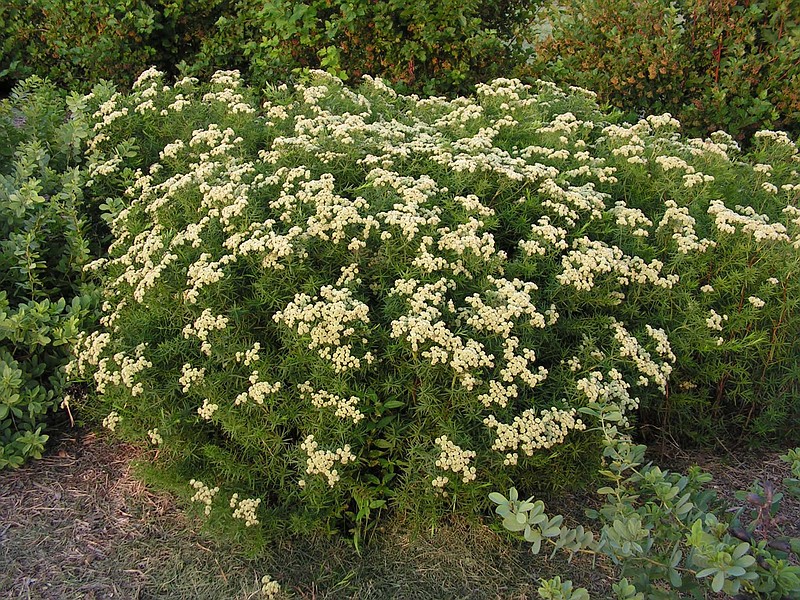If someone told you to go and find a bunch of mountain mints, where would you look? Strangely enough, if you went looking for mountain mints in the mountains, you might have a hard time finding them. Instead, try looking in dry to moist prairies, glades, savannas, woodlands and even in margins of rivers. They can even be persistent in roadsides and other mowed disturbed sites if they are spared from being sprayed with herbicides. This time of year, we can see them sprouting at soil level, just waiting patiently for those warm days in April to start really growing. They spread from rhizomes, forming colonies, which make them suitable for sites with erosion problems, but mountain mints do not spread as much as the introduced "true mints" in the Mentha genus, like spearmint (M. spicata).
In gardens, mountain mints do well under full sun to moderate shade and from dry to moist sites with good drainage. An added bonus is that deer do not like them, so they do well in heavily browsed areas.
In Missouri, we have six species of mountain mints. The two most common and widely spread are slender mountain mint (Pycnanthemum tenuifolium) and hairy mountain mint (P. pilosum or P. verticillatum var. pilosum). They are perennials and widely available in native plant nurseries.
The difference between these two "mountain mints" is that hairy mountain mint has very hairy, or pubescent, leaves and stems, as you would guess from the name, while slender mountain mint doesn't. Slender mountain mint has a naturally bushier shape than hairy mountain mint, but both can be planted in groupings in gardens or be included in native plant seed mixes for prairie restoration projects or to improve habitat for pollinators. These and most mints, native or not, are important pollinator plants. In our yard in Columbia, we have both mountains mints. They are visited by small and large butterflies and a myriad of other insects like flies, native bees, beetles and wasps. Doug Ladd in his book "Tallgrass Prairie Wildflowers" mentions that flowers are produced from late spring to late summer.
These mountain mints grow from 2-4 feet in height, shorter than Monarda species. Like other mints they respond well to pruning if shorter plants are desired. The clippings can be used to prepare teas or infusions to flavor desserts.
We are fortunate to have so many native mints, mountain and otherwise, available in Missouri. In previous "Dining Wild" columns, I have discussed dittany (Cunila origanoides), Bergamot and several Monarda species. They all belong to the mint family or Lamiaceae with characteristic square stems and can be propagated easily from seed or cuttings.
Leaves can be harvested any time of the year for recipes, but tender shoots are better. They can be used fresh or dried to store for later use. My experience with these mountain mints is the leaves of hairy mountain mint are more aromatic than slender mountain mint, but both have similar scent. In the recipe for this article, I gathered fresh hairy mountain mint from spring to summer. I clip some plants through the growing season to get new growth available for cooking.
According to George Yatskievych in his "Flora of Missouri," volume 3, other less common mountain mints in Missouri include white mountain mint (P. albescens) found in 26 southern counties, Torrey's mountain mint (P. torreyi), present only in Dunklin County, Virginia mountain mint (P. virginianum), scattered in the Ozarks and across the state and clustered mountain mint (P. muticum), present only in six counties in southeast Missouri. This last one has been named the plant of the year by The Garden Club of America; however its range is restricted to Texas and most of the eastern United States.
I was surprised to find so little information about these mints in the books about native edibles that I consulted. Of these, Kelly Kishner in his book "Native Edible Plants from the Prairie" mentions the genus Pycnanthemun, in general, to be used to prepare a tasty tea. Daniel. E. Moerman's "Native American Food Plants," a dictionary of ethnobotany, mentions three species: P. virginianum, used by the Chippewa and P. flexuoxun and P. incanum, used by the Cherokee. The last two are not native to Missouri and with more limited range of distribution.
Bottom line is, if you want to feel refreshed and invigorated, adopt mountain mints in your garden for their wonderful flavors, to see their beautiful flowers and their happy pollinators. ou and your little friends will be glad you did!
Native Plant Events near you
On Saturday, the Missouri Prairie Foundation is hosting a native plant sale in Sedalia. Here, a wide variety of native perennial wildflowers, grasses, sedges, vines, shrubs and trees, as well as seeds, supplied by four native plant vendors will be available for sale from 10 a.m.-2 p.m. at the State Fair Fairgrounds near the corner of U.S. 65 and 16th Street.
Also, on April 14, a Native Plant Sale & Education Day is scheduled from 10 a.m.-2 p.m. at Bradford Research Center (Farm), 4968 South Rangeline Road in Columbia. For additional locations, visit grownative.org. These events are free. I will offer two classes at the Career Center in Columbia about native edibles. You will learn to identify, grow, harvest and prepare them. These classes are not about foraging, but about how to adopt native edibles in your gardens or farms with the potential of growing them for income. The class on April 26 is about fruits, nuts and roots, and the one on April 30 is about flowers, stems and leaves. Food samples prepared with native edible plants are provided during each class. To register, visit the Career Center's website at cacc.asapconnected.com/default.aspx.
Dr. Nadia Navarrete-Tindall is a native plants specialist, educator and independent consultant. She offers training about native edible plants and other topics on native plants, in English and Spanish, as well as consultation on native plants for yards and acreages. She is an advisory board member for Grow Native. She lives in Columbia, Missouri, with her husband Randy and their dog Bonita. She can be reached by email at [email protected] or on her Facebook page, "Native Plants and More."
Mountain Mint Chocolate Cheesecake with pecan pie crust
Make one 12-inch cake; serves 12
Ingredients
For filling
cup heavy cream
8- 8 to 12 inch hairy mountain mint cuttings,
cup sugar
3 8oz. packages cream cheese at room temperature
3 eggs
cup semi-sweet chocolate chips or replace with dry cranberries
For crust
cup ground pecans small Missouri pecans are best
1 cup acorn flour (specialty stores or prepare your own)
cup rolled oats
1 tsp. ground cinnamon
4 oz. unsalted butter
1 to tablespoon maple syrup
tsp. salt
It works better to use a springform pan
Directions
In a medium sauce pan, place mint cuttings and cover with a cup of heavy cream. Bring to a simmer, remove from heat and let steep for 1 to 3 hours. Before using, strain mint cuttings from cream.
Preheat the oven to 350 degrees Fahrenheit. To prepare the crust, mix together pecans, flour, cinnamon and salt. Add minced butter and maple syrup to make a ball. Place the ball into springform pan pressing the dough from the center toward the edges with your fingers. Cover entire pan. Cool it down in refrigerator for 1 to 2 hours and bake it for 5 minutes before adding cheesecake filling.
Beat the cream cheese and cup sugar in a mixer until fluffy. Add the eggs one at a time. Beat in the minty cream until mixed well. Fold half of the chocolate chips (or cranberries) in the batter. Pour batter over crust and sprinkle remaining chips or cranberries over the top of the cheesecake.
Bake for 45 minutes to 1 hour. To check if it is done insert a knife in the middle of the pie. If it comes out clean is ready. Place pan on wire rack to cool. Chill overnight.


